Abstract
In this paper I review the ways in which the glassy state is obtained both in nature and in materials science and highlight a "new twist"--the recent recognition of polymorphism within the glassy state. The formation of glass by continuous cooling (viscous slowdown) is then examined, the strong/fragile liquids classification is reviewed, and a new twist-the possibility that the slowdown is a result of an avoided critical point-is noted. The three canonical characteristics of relaxing liquids are correlated through the fragility. As a further new twist, the conversion of strong liquids to fragile liquids by pressure-induced coordination number increases is demonstrated. It is then shown that, for comparable systems, it is possible to have the same conversion accomplished via a first-order transition within the liquid state during quenching. This occurs in the systems in which "polyamorphism" (polymorphism in the glassy state) is observed, and the whole phenomenology is accounted for by Poole's bond-modified van der Waals model. The sudden loss of some liquid degrees of freedom through such weak first-order transitions is then related to the polyamorphic transition between native and denatured hydrated proteins, since the latter are also glass-forming systems--water-plasticized, hydrogen bond-cross-linked chain polymers (and single molecule glass formers). The circle is closed with a final new twist by noting that a short time scale phenomenon much studied by protein physicists-namely, the onset of a sharp change in d<r2>/dT (<r2> is the Debye-Waller factor)--is general for glass-forming liquids, including computer-simulated strong and fragile ionic liquids, and is closely correlated with the experimental glass transition temperature. The latter thus originates in strong anharmonicity in certain components of the vibrational density of states, which permits the system to access the multiple minima of its configuration space. The connection between the anharmonicity in these modes, vibrational localization, the Kauzmann temperature, and the fragility of the liquid is proposed as the key problem in glass science.
Full text
PDF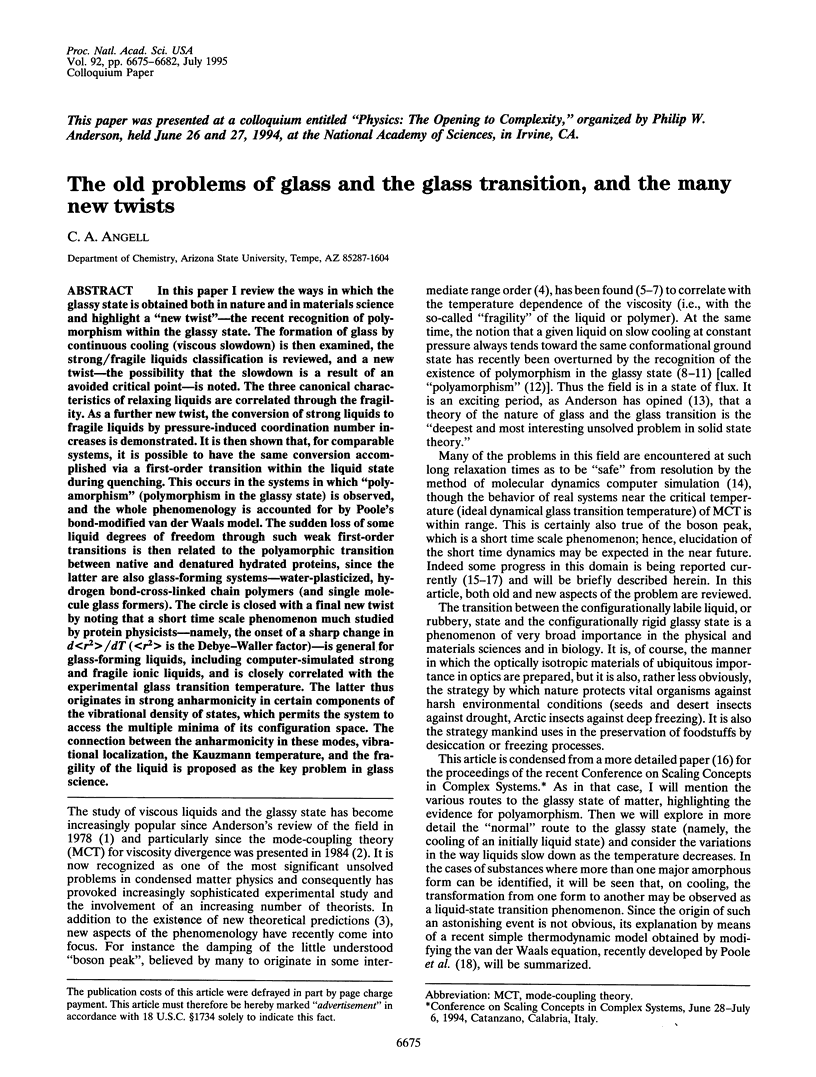
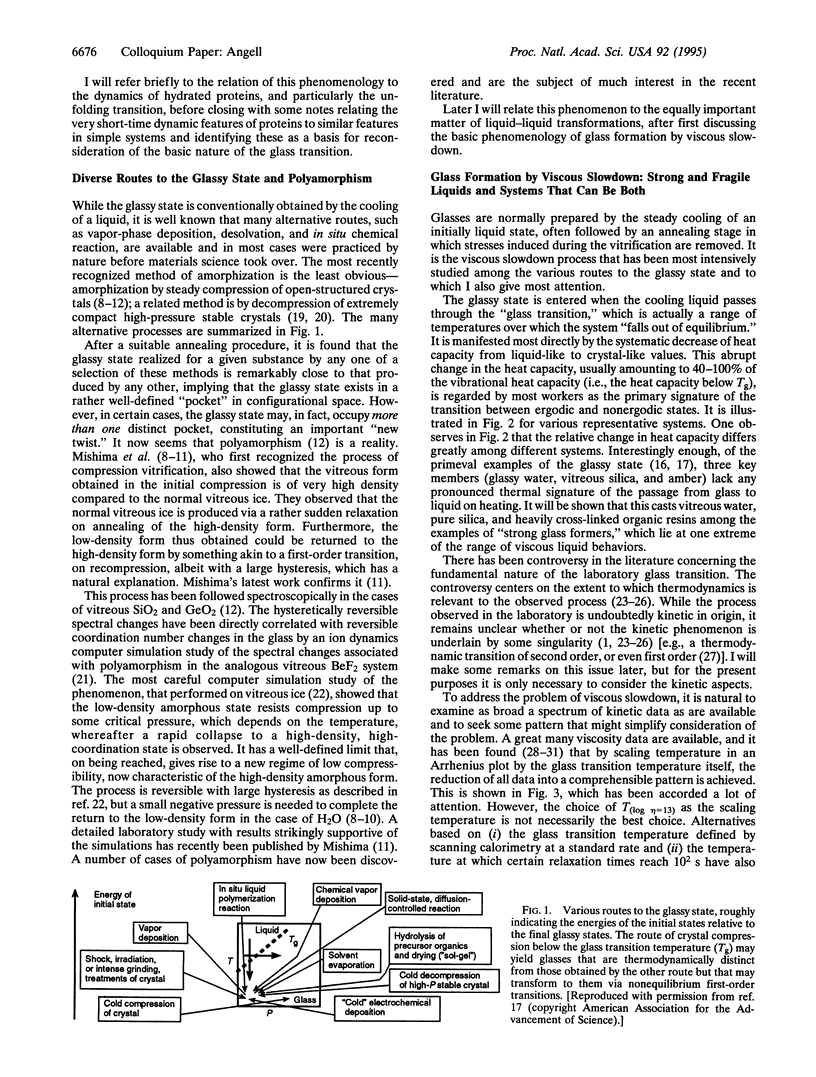
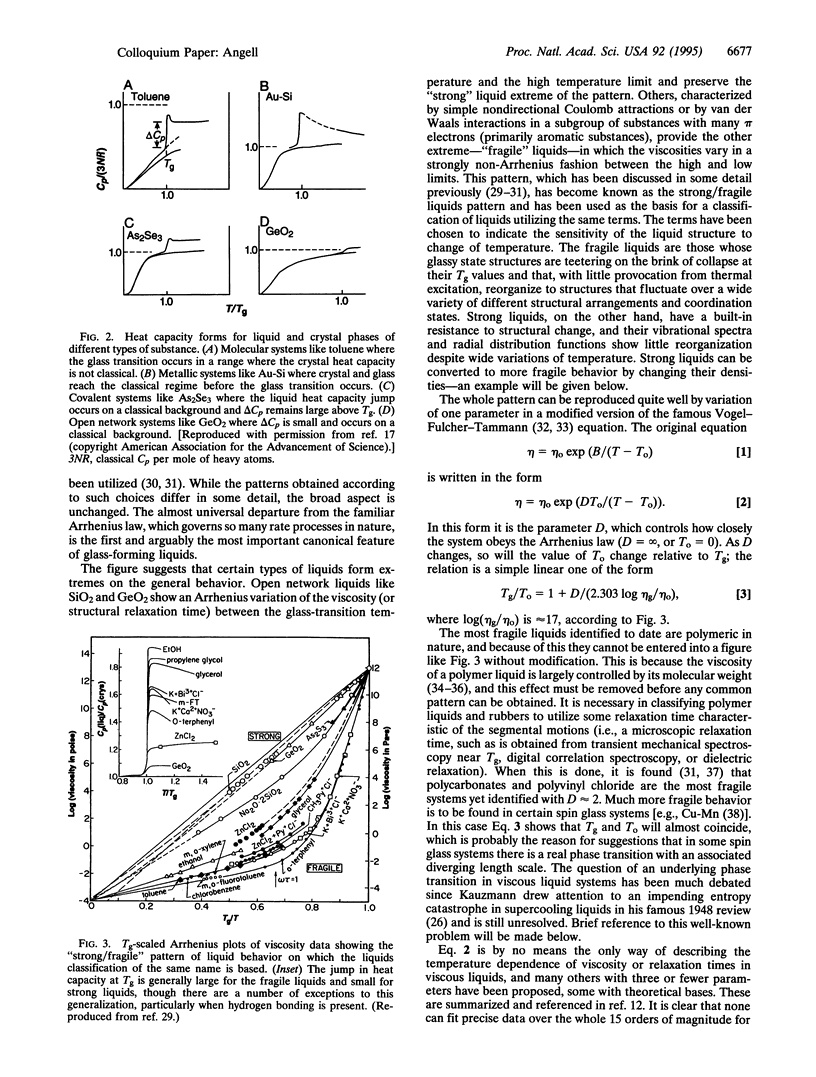

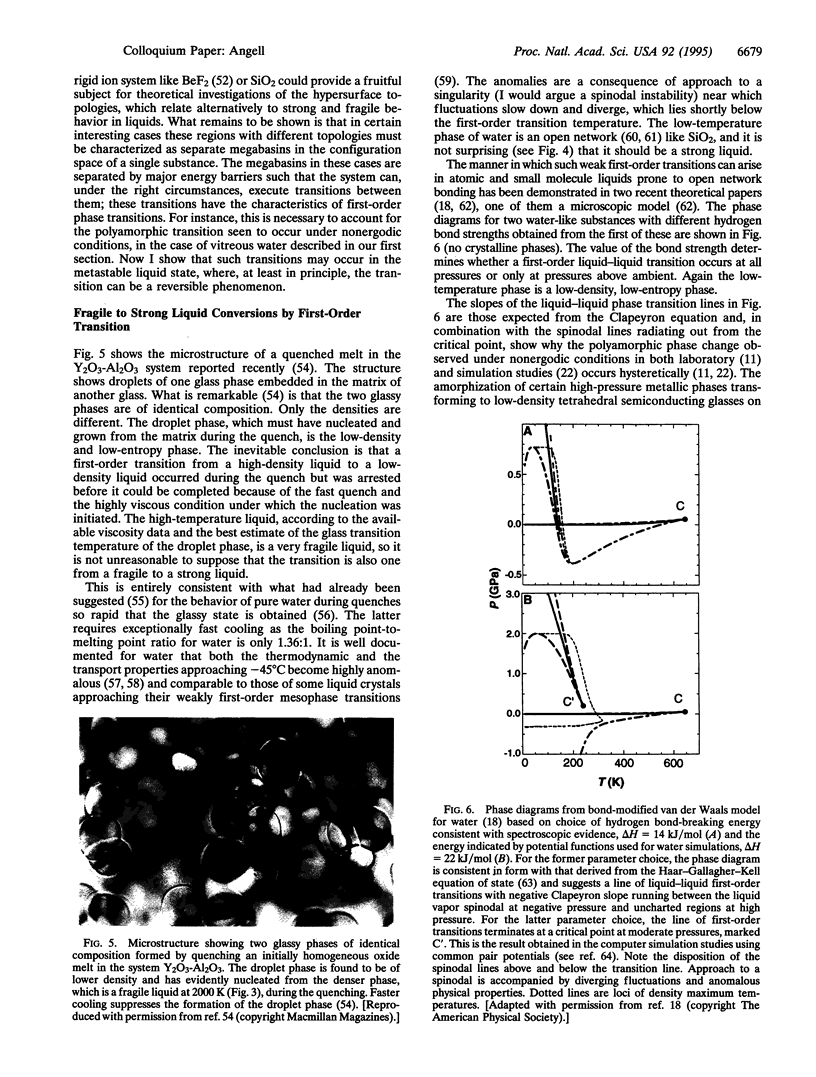
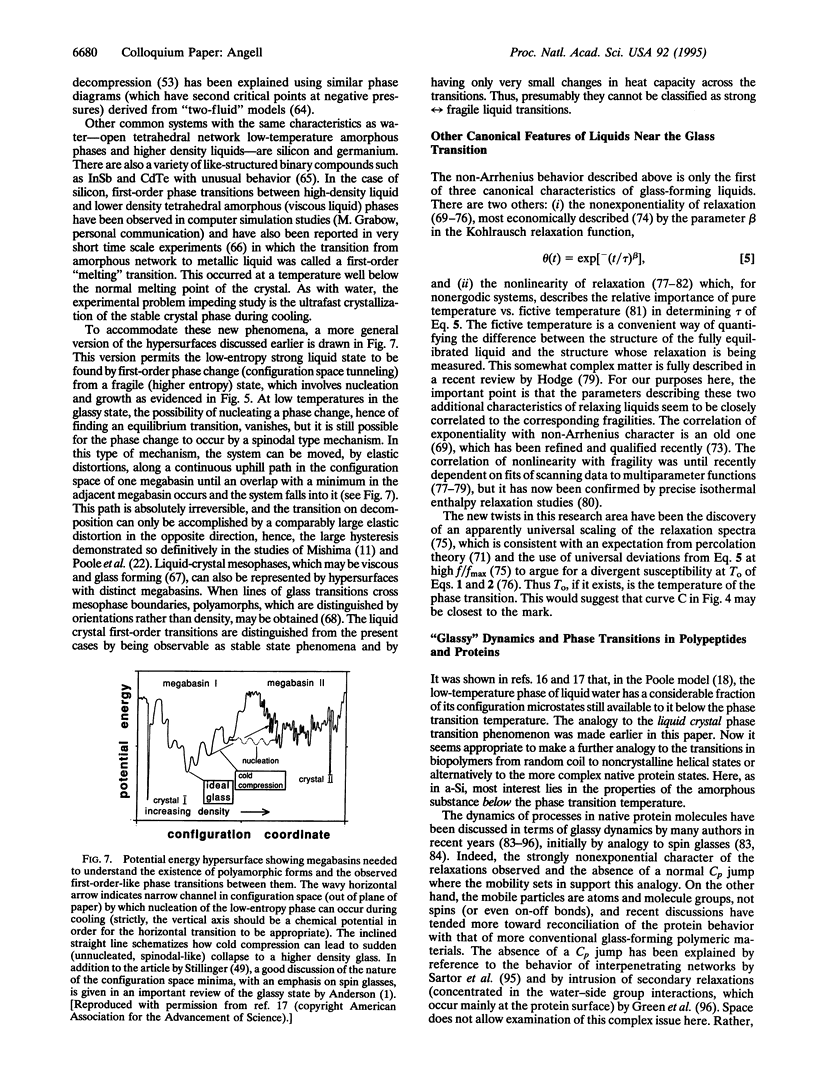
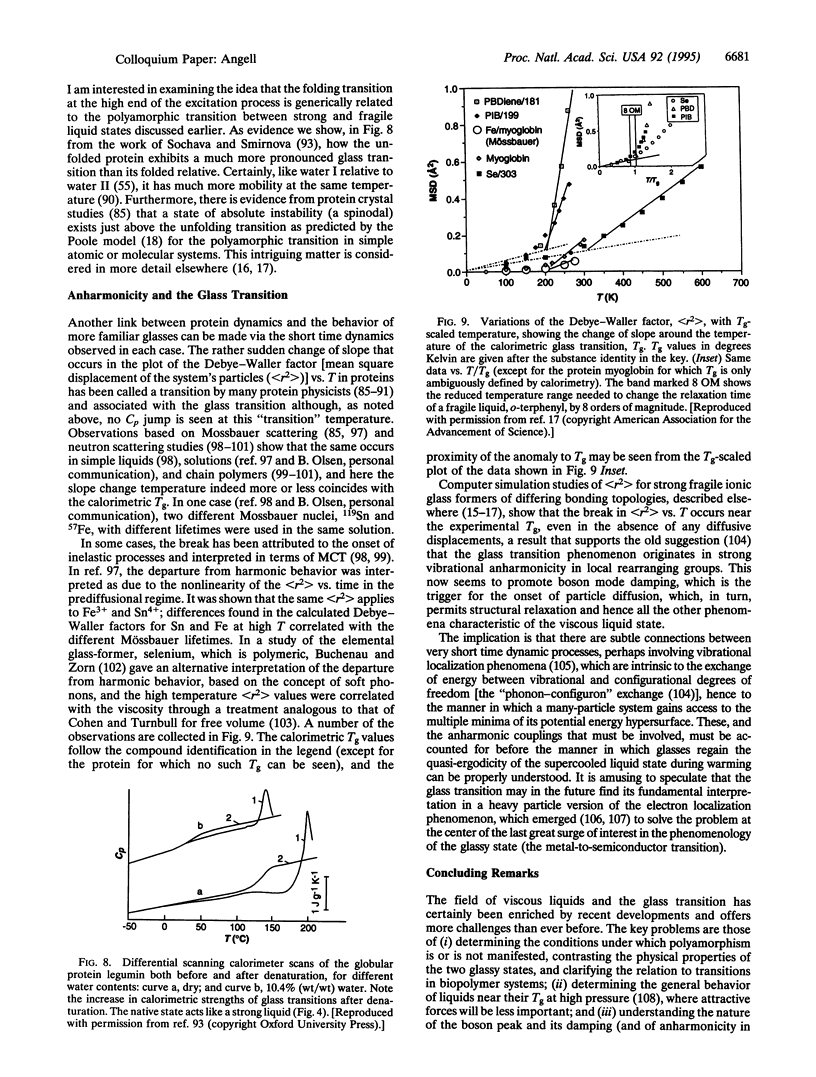
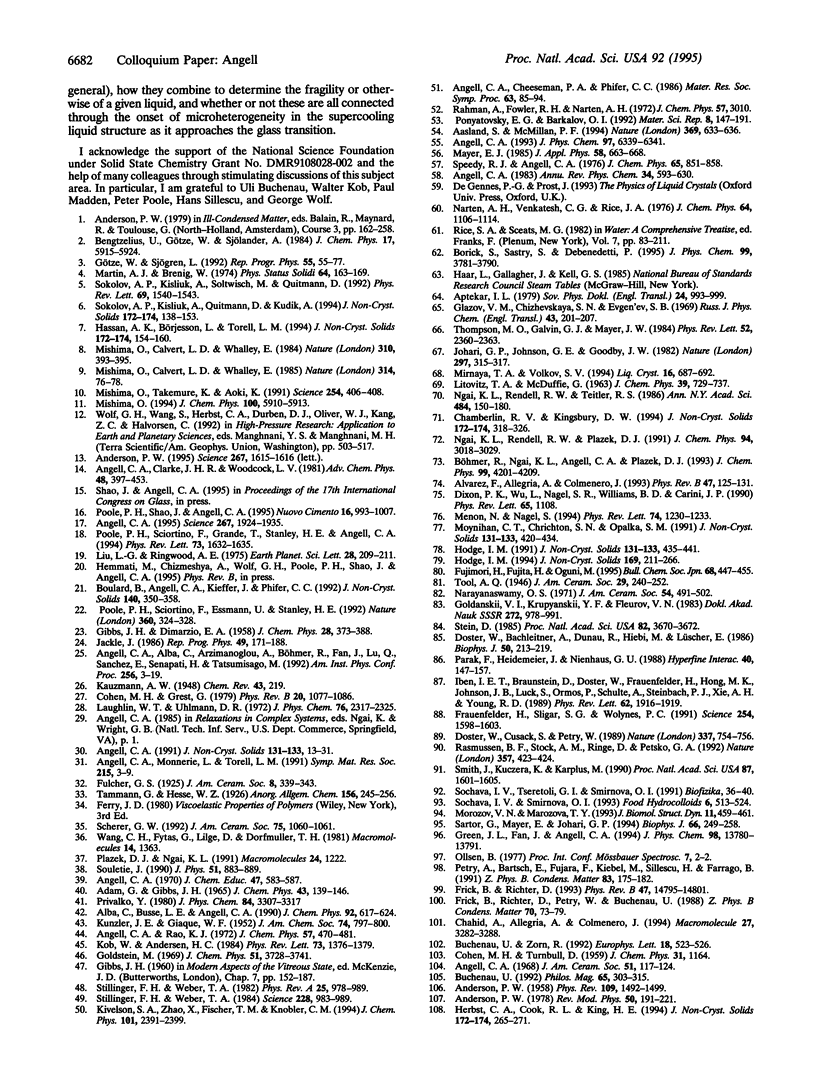
Images in this article
Selected References
These references are in PubMed. This may not be the complete list of references from this article.
- Anderson P. W. Through the glass lightly. Science. 1995 Mar 17;267(5204):1615–1616. doi: 10.1126/science.267.5204.1615-e. [DOI] [PubMed] [Google Scholar]
- Angell C. A. Formation of glasses from liquids and biopolymers. Science. 1995 Mar 31;267(5206):1924–1935. doi: 10.1126/science.267.5206.1924. [DOI] [PubMed] [Google Scholar]
- Dixon PK, Wu L, Nagel SR, Williams BD, Carini JP. Scaling in the relaxation of supercooled liquids. Phys Rev Lett. 1990 Aug 27;65(9):1108–1111. doi: 10.1103/PhysRevLett.65.1108. [DOI] [PubMed] [Google Scholar]
- Doster W., Bachleitner A., Dunau R., Hiebl M., Lüscher E. Thermal properties of water in myoglobin crystals and solutions at subzero temperatures. Biophys J. 1986 Aug;50(2):213–219. doi: 10.1016/S0006-3495(86)83455-5. [DOI] [PMC free article] [PubMed] [Google Scholar]
- Doster W., Cusack S., Petry W. Dynamical transition of myoglobin revealed by inelastic neutron scattering. Nature. 1989 Feb 23;337(6209):754–756. doi: 10.1038/337754a0. [DOI] [PubMed] [Google Scholar]
- Frauenfelder H., Sligar S. G., Wolynes P. G. The energy landscapes and motions of proteins. Science. 1991 Dec 13;254(5038):1598–1603. doi: 10.1126/science.1749933. [DOI] [PubMed] [Google Scholar]
- Frick B, Richter D. Change of the vibrational dynamics near the glass transition in polyisobutylene: Inelastic neutron scattering on a nonfragile polymer. Phys Rev B Condens Matter. 1993 Jun 1;47(22):14795–14804. doi: 10.1103/physrevb.47.14795. [DOI] [PubMed] [Google Scholar]
- Iben IE, Braunstein D, Doster W, Frauenfelder H, Hong MK, Johnson JB, Luck S, Ormos P, Schulte A, Steinbach PJ. Glassy behavior of a protein. Phys Rev Lett. 1989 Apr 17;62(16):1916–1919. doi: 10.1103/PhysRevLett.62.1916. [DOI] [PubMed] [Google Scholar]
- Kob W, Andersen HC. Scaling behavior in the beta -relaxation regime of a supercooled Lennard-Jones mixture. Phys Rev Lett. 1994 Sep 5;73(10):1376–1379. doi: 10.1103/PhysRevLett.73.1376. [DOI] [PubMed] [Google Scholar]
- Menon N, Nagel SR. Evidence for a divergent susceptibility at the glass transition. Phys Rev Lett. 1995 Feb 13;74(7):1230–1233. doi: 10.1103/PhysRevLett.74.1230. [DOI] [PubMed] [Google Scholar]
- Mishima O., Takemura K., Aoki K. Visual Observations of the Amorphous-Amorphous Transition in H2O Under Pressure. Science. 1991 Oct 18;254(5030):406–408. doi: 10.1126/science.254.5030.406. [DOI] [PubMed] [Google Scholar]
- Morozov V. N., Morozova TYa Elasticity of globular proteins. The relation between mechanics, thermodynamics and mobility. J Biomol Struct Dyn. 1993 Dec;11(3):459–481. doi: 10.1080/07391102.1993.10508010. [DOI] [PubMed] [Google Scholar]
- Poole PH, Sciortino F, Grande T, Stanley HE, Angell CA. Effect of hydrogen bonds on the thermodynamic behavior of liquid water. Phys Rev Lett. 1994 Sep 19;73(12):1632–1635. doi: 10.1103/PhysRevLett.73.1632. [DOI] [PubMed] [Google Scholar]
- Rasmussen B. F., Stock A. M., Ringe D., Petsko G. A. Crystalline ribonuclease A loses function below the dynamical transition at 220 K. Nature. 1992 Jun 4;357(6377):423–424. doi: 10.1038/357423a0. [DOI] [PubMed] [Google Scholar]
- Sartor G., Mayer E., Johari G. P. Calorimetric studies of the kinetic unfreezing of molecular motions in hydrated lysozyme, hemoglobin, and myoglobin. Biophys J. 1994 Jan;66(1):249–258. doi: 10.1016/S0006-3495(94)80774-X. [DOI] [PMC free article] [PubMed] [Google Scholar]
- Smith J., Kuczera K., Karplus M. Dynamics of myoglobin: comparison of simulation results with neutron scattering spectra. Proc Natl Acad Sci U S A. 1990 Feb;87(4):1601–1605. doi: 10.1073/pnas.87.4.1601. [DOI] [PMC free article] [PubMed] [Google Scholar]
- Sokolov AP, Kisliuk A, Soltwisch M, Quitmann D. Medium-range order in glasses: Comparison of Raman and diffraction measurements. Phys Rev Lett. 1992 Sep 7;69(10):1540–1543. doi: 10.1103/PhysRevLett.69.1540. [DOI] [PubMed] [Google Scholar]
- Stillinger F. H., Weber T. A. Packing structures and transitions in liquids and solids. Science. 1984 Sep 7;225(4666):983–989. doi: 10.1126/science.225.4666.983. [DOI] [PubMed] [Google Scholar]



